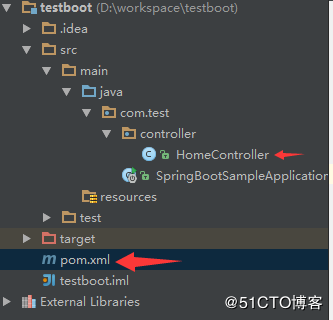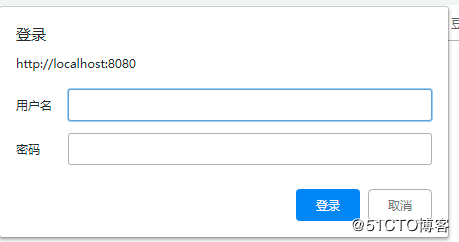springboot 支持springsecurity 自定义数据库查询
本文将具体介绍在Spring Boot中如何使用Spring Security进行安全控制,权限控制数据均有数据库查询。
1.背景
Spring Security 主要是在访问前添加过滤器,过滤器中主要起作用的为 访问鉴权authenticationManager (有没有权限访问系统) 和 访问决策器accessDecisionManager (可以访问系统的哪些资源,当时此处涉及查询数据库资源,还需要数据资源查询securityMetadataSource),具体的对应springmvc 中的配置地址为: http://blog.51cto.com/5148737/1615882,本文将基于上文的改造,改造成springboot版本。
2.添加maven依赖
<dependency>
<groupId>org.springframework.boot</groupId>
<artifactId>spring-boot-starter-security</artifactId>
</dependency>
<!-- 如果需要jsp支持security标签,需要添加这个 -->
<dependency>
<groupId>org.springframework.security</groupId>
<artifactId>spring-security-taglibs</artifactId>
</dependency>
到此为止,项目路径如下

pom.xml
<?xml version="1.0" encoding="UTF-8"?>
<project xmlns="http://maven.apache.org/POM/4.0.0"
xmlns:xsi="http://www.w3.org/2001/XMLSchema-instance"
xsi:schemaLocation="http://maven.apache.org/POM/4.0.0 http://maven.apache.org/xsd/maven-4.0.0.xsd">
<modelVersion>4.0.0</modelVersion>
<groupId>com.gosun</groupId>
<artifactId>cdn</artifactId>
<version>1.0-SNAPSHOT</version>
<parent>
<groupId>org.springframework.boot</groupId>
<artifactId>spring-boot-starter-parent</artifactId>
<version>1.4.0.RELEASE</version>
</parent>
<dependencies>
<dependency>
<groupId>org.springframework.boot</groupId>
<artifactId>spring-boot-starter-web</artifactId>
</dependency>
<dependency>
<groupId>org.springframework.boot</groupId>
<artifactId>spring-boot-starter-security</artifactId>
</dependency>
</dependencies>
</project>
HomeController.java
@Controller
public class HomeController {
@RequestMapping("/")
public void index(HttpServletRequest request,HttpServletResponse response) throws IOException {
response.getWriter().write("index");
}
}
这个时候如果项目跑起来的话,springsecurity会使用内部默认控制,控制台会打印密码,用户名为user,如下

但是我们要讲的是,自定义权限控制,ok,下面继续
3.构建securiy配置文件 WebSecurityConfig,需要继承WebSecurityConfigurerAdapter
在这个类中,加入了自定义 访问鉴权,访问决策器,资源池查询
@Configuration
@EnableWebSecurity
public class WebSecurityConfig extends WebSecurityConfigurerAdapter {
@Autowired
private MyUserDetailService userDetailService;
@Autowired
private AuthenticationSuccessHandler authenticationSuccessHandler;
@Override
protected void configure(AuthenticationManagerBuilder auth) throws Exception {
DaoAuthenticationProvider authProvider = new DaoAuthenticationProvider();
authProvider.setPasswordEncoder(passwordEncoder());
authProvider.setUserDetailsService(userDetailService);
ReflectionSaltSource saltSource = new ReflectionSaltSource();
saltSource.setUserPropertyToUse("username");
authProvider.setSaltSource(saltSource);
auth.authenticationProvider(authProvider);
}
@Bean
public Md5PasswordEncoder passwordEncoder() {
return new Md5PasswordEncoder();
}
@Override
protected void configure(HttpSecurity http) throws Exception {
http.csrf().disable();
http.authorizeRequests()
.antMatchers("/assets/**", "/portal/**", "/login","/redirect","/login/**").permitAll()
.antMatchers("/schedual/area_isp_ip", "/403", "/404.jsp", "/logout", "/favicon.ico","/favicon.html").permitAll()
.anyRequest().authenticated()
.and()
.formLogin()
.loginPage("/login")
.successHandler(authenticationSuccessHandler).defaultSuccessUrl("/").permitAll()
.failureUrl("/login?error").permitAll()
.and()
.logout()
.permitAll()
.withObjectPostProcessor(new ObjectPostProcessor<FilterSecurityInterceptor>() {
public <O extends FilterSecurityInterceptor> O postProcess(
O fsi) {
fsi.setSecurityMetadataSource(mySecurityMetadataSource());
fsi.setAccessDecisionManager(myAccessDecisionManager());
return fsi;
}
});
}
@Bean
public FilterInvocationSecurityMetadataSource mySecurityMetadataSource() {
MyInvocationSecurityMetadataSourceService securityMetadataSource = new MyInvocationSecurityMetadataSourceService();
return securityMetadataSource;
}
@Bean
public AccessDecisionManager myAccessDecisionManager() {
return new MyAccessDecisionManager();
}
}
相关说明:
-
该类需要继承WebSecurityConfigurerAdapter,重写configure方法,注解
@Configuration:为配置文件,自动加载;
@EnableWebSecurity:表示开启security权限控制
-
configure(HttpSecurity http)
http.csrf().disable() 禁用了csrf,支持jsp时需要加此条件
http.authorizeRequests().xxxxx 开始添加相关条件
antMatchers.....为需要过滤的url,即这些地址url都不需要进行权校验
.formLogin().loginPage("/login") 定义了默认的登陆地址
.successHandler.....定义了登陆成功后的处理方法,主要将用户信息放入session等
.failureUrl.....定义了失败的url
.withObjectPostProcessor......则定义了访问决策器、资源池查询 两个方法
springmvc中定义filter,将访问决策器、访问决策器、资源池查询定义在filter中,在网上一些案例中,看到其他文章springboot 整合springsecurity的时候,采用添加filter的方式,但是亲自试验后发现有问题,antMatchers会失效,如果所有的url都需要进行权限校验,那么可以采用添加filter的形式,但是如果向上述,需要部分url比如说静态文件直接可以访问,那么必须采用这种withObjectPostProcessor的方式。
-
configure(AuthenticationManagerBuilder auth) 定义了访问鉴权
其中鉴权最重要的是需要 authProvider,
setPasswordEncoder :定义何种密码校验方式Md5PasswordEncoder
setUserDetailsService :自定义了数据库查询用户
setSaltSource :密码添加盐值
4.资源池查询类( MyInvocationSecurityMetadataSourceService )
public class MyInvocationSecurityMetadataSourceService implements FilterInvocationSecurityMetadataSource {
private AntPathMatcher urlMatcher = new AntPathMatcher();
private static Map <String,Collection <ConfigAttribute>> resourceMap = null;
@Autowired
CommonDao commonDao;
/**
* 加载URL权限配置
*/
private void loadResourceDefine() {
long starttime = new Date().getTime();
String sql = "SELECT * FROM auth_resource";
resourceMap = new HashMap<String,Collection <ConfigAttribute >> ();
List<Properties> resourceList = commonDao.queryForList(sql);
List<Map> roleList = commonDao.queryForList("SELECT * FROM auth_role");
Map<String,String> roleIdMap = new HashMap();
for(Map roleMap:roleList){
String roleId = roleMap.get("id").toString();
String rolename = roleMap.get("rolename").toString();
roleIdMap.put(roleId, rolename);
}
long endtime = new Date().getTime();
System.out.println("查询完毕,耗时"+(endtime-starttime)+"ms");
for(Map dataMap:resourceList){
String urlPattern ="";
if(dataMap.get("url_pattern")!=null){
urlPattern = dataMap.get("url_pattern").toString();
}
String[] roleIds = new String[0];
if(dataMap.get("access_role")!=null&&!dataMap.get("access_role").equals("")){
String acce***ole = dataMap.get("access_role").toString();
roleIds = acce***ole.split(",");
}
Collection <ConfigAttribute> atts = new ArrayList < ConfigAttribute >();
for(String roleId:roleIds){
ConfigAttribute ca = new SecurityConfig(roleIdMap.get(roleId));
atts.add(ca);
}
resourceMap.put(urlPattern,atts);
}
endtime = new Date().getTime();
System.out.println("加载系统权限配置完毕,耗时"+(endtime-starttime)+"ms");
}
public boolean isResourceMapEmpty(){
if(resourceMap==null){
return true;
}else{
return false;
}
}
public Collection<ConfigAttribute> getAllConfigAttributes() {
// TODO Auto-generated method stub
return null;
}
public Collection<ConfigAttribute> getAttributes(Object object)
throws IllegalArgumentException {
if(resourceMap==null) {
loadResourceDefine();
}
// TODO Auto-generated method stub
String url =((FilterInvocation)object).getRequestUrl();
if(resourceMap != null){
Set<String> urlPatternSet = resourceMap.keySet();
for(String urlPattern:urlPatternSet){
if(urlMatcher.match(urlPattern, url)){
return resourceMap.get(urlPattern);
}
}
}
return null;
}
public boolean supports(Class<?> arg0) {
// TODO Auto-generated method stub
return true;
}
public String resourceSelfMatcher(String resURL){
return null;
}
/**
* 刷新资源配置
*/
public void refreshResource(){
loadResourceDefine();
}
}
5.访问决策器( MyAccessDecisionManager )
public class MyAccessDecisionManager implements AccessDecisionManager {
@Autowired
MyInvocationSecurityMetadataSourceService securityMetadataSource;
public void decide(Authentication authentication, Object object,Collection<ConfigAttribute> configAttributes) throws AccessDeniedException,InsufficientAuthenticationException {
// TODO Auto-generated method stub
// if(securityMetadataSource.isResourceMapEmpty()){
// securityMetadataSource.refreshResource();
// }
if (configAttributes == null ) throw new AccessDeniedException("对不起,您没有此权限");
SimpleDateFormat sdf = new SimpleDateFormat("yyyy-MM-dd HH:mm:ss");
System.out.println(sdf.format(new Date())+":/t"+object.toString());
for(ConfigAttribute ca:configAttributes){
String needRole = ca.getAttribute();
for(GrantedAuthority userGA:authentication.getAuthorities()) {
if(needRole.equals(userGA.getAuthority())) { // ga is user's role.
return ;
}
}
}
throw new AccessDeniedException("对不起,您没有此权限");
}
public boolean supports(ConfigAttribute arg0) {
// TODO Auto-generated method stub
return true;
}
public boolean supports(Class<?> arg0) {
// TODO Auto-generated method stub
return true;
}
}
6.自定义用户查询( MyUserDetailService )
@Service("myUserDetailService")
public class MyUserDetailService implements UserDetailsService {
@Autowired
CommonDao commonDao;
String userTable = "auth_user";
String roleTable = "auth_role";
String menuTable = "auth_resource";
public UserDetails loadUserByUsername(String username)throws UsernameNotFoundException, DataAccessException {
Map userMap= commonDao.queryForOne("SELECT * FROM `"+userTable+"` WHERE username='"+username+"'");
if(userMap!=null&userMap.containsKey("username")){
//初始化角色信息
Collection <GrantedAuthority> authorities = new ArrayList<GrantedAuthority>();
String[] userRoles = userMap.get("user_role").toString().split(",");
for(String userRole:userRoles){
Map roleMap = commonDao.queryForOne("SELECT * FROM `"+roleTable+"` WHERE id="+ userRole);
if(roleMap!=null && roleMap.containsKey("rolename")){
SimpleGrantedAuthority authority = new SimpleGrantedAuthority(roleMap.get("rolename").toString());
authorities.add(authority);
}
}
boolean enabled = false;
String nickname = username;
String telephone = "";
String email = "";
int sex = 0;
String password = "";
if(userMap.get("telephone")!=null) telephone = userMap.get("telephone").toString();
if(userMap.get("password")!=null) password = userMap.get("password").toString();
if(userMap.get("nickname")!=null) nickname = userMap.get("nickname").toString();
if(userMap.get("email")!=null) email = userMap.get("email").toString();
if(userMap.get("sex")!=null) sex = Integer.parseInt(userMap.get("sex").toString());
if(Integer.parseInt(userMap.get("enabled").toString())==1) enabled = true;
User userdtails = new User(username, password, enabled, true, true,true, authorities,null,nickname,telephone,email,sex);
return userdtails;
}else{
return null;
}
}
}
7.权限校验成功返回handler ( AuthenticationSuccessHandler )
@Service
public class AuthenticationSuccessHandler extends SavedRequestAwareAuthenticationSuccessHandler {
@Autowired
private CommonDao commonDao;
private RequestCache requestCache;
public AuthenticationSuccessHandler(){
this.requestCache = new HttpSessionRequestCache();
}
@Override
public void onAuthenticationSuccess(HttpServletRequest request,HttpServletResponse response, Authentication authentication)throws ServletException, IOException {
User userDetails = (User) SecurityContextHolder.getContext().getAuthentication().getPrincipal();
request.getSession().setAttribute("userDetails", userDetails);
super.onAuthenticationSuccess(request, response, authentication);
return;
}
}
- 本文标签: UI id Select tag spring build mail cat bean NSA 权限控制 SpringMVC web Word js 配置 Collection parse equals rmi schema pom 数据库 Service Menu springboot list apache http https map IO HTML ArrayList logo dataSource maven tar Property IDE Spring Security key ssh src ip sql cache App session provider tab Security 数据 Spring Boot XML java lib servlet 安全 ORM CTO HashMap dependencies authenticate 文章 CDN
- 版权声明: 本文为互联网转载文章,出处已在文章中说明(部分除外)。如果侵权,请联系本站长删除,谢谢。
- 本文海报: 生成海报一 生成海报二











![[HBLOG]公众号](https://www.liuhaihua.cn/img/qrcode_gzh.jpg)

